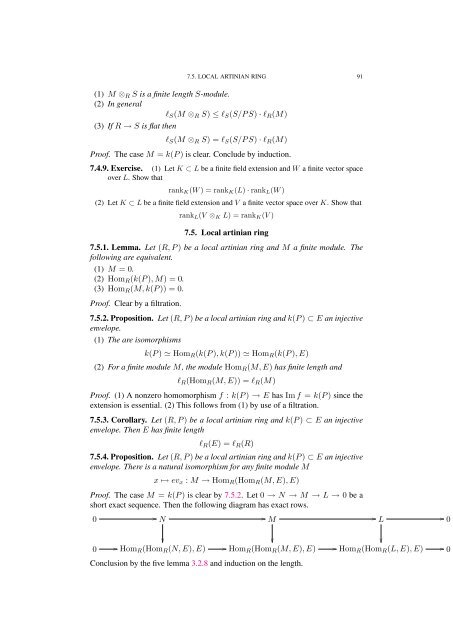Commutative algebra - Department of Mathematical Sciences - old ...
Commutative algebra - Department of Mathematical Sciences - old ...
Commutative algebra - Department of Mathematical Sciences - old ...
You also want an ePaper? Increase the reach of your titles
YUMPU automatically turns print PDFs into web optimized ePapers that Google loves.
7.5. LOCAL ARTINIAN RING 91<br />
(1) M ⊗R S is a finite length S-module.<br />
(2) In general<br />
ℓS(M ⊗R S) ≤ ℓS(S/P S) · ℓR(M)<br />
(3) If R → S is flat then<br />
ℓS(M ⊗R S) = ℓS(S/P S) · ℓR(M)<br />
Pro<strong>of</strong>. The case M = k(P ) is clear. Conclude by induction.<br />
7.4.9. Exercise. (1) Let K ⊂ L be a finite field extension and W a finite vector space<br />
over L. Show that<br />
rankK(W ) = rankK(L) · rankL(W )<br />
(2) Let K ⊂ L be a finite field extension and V a finite vector space over K. Show that<br />
rankL(V ⊗K L) = rankK(V )<br />
7.5. Local artinian ring<br />
7.5.1. Lemma. Let (R, P ) be a local artinian ring and M a finite module. The<br />
following are equivalent.<br />
(1) M = 0.<br />
(2) HomR(k(P ), M) = 0.<br />
(3) HomR(M, k(P )) = 0.<br />
Pro<strong>of</strong>. Clear by a filtration.<br />
7.5.2. Proposition. Let (R, P ) be a local artinian ring and k(P ) ⊂ E an injective<br />
envelope.<br />
(1) The are isomorphisms<br />
k(P ) HomR(k(P ), k(P )) HomR(k(P ), E)<br />
(2) For a finite module M, the module HomR(M, E) has finite length and<br />
ℓR(HomR(M, E)) = ℓR(M)<br />
Pro<strong>of</strong>. (1) A nonzero homomorphism f : k(P ) → E has Im f = k(P ) since the<br />
extension is essential. (2) This follows from (1) by use <strong>of</strong> a filtration.<br />
7.5.3. Corollary. Let (R, P ) be a local artinian ring and k(P ) ⊂ E an injective<br />
envelope. Then E has finite length<br />
ℓR(E) = ℓR(R)<br />
7.5.4. Proposition. Let (R, P ) be a local artinian ring and k(P ) ⊂ E an injective<br />
envelope. There is a natural isomorphism for any finite module M<br />
x ↦→ evx : M → HomR(HomR(M, E), E)<br />
Pro<strong>of</strong>. The case M = k(P ) is clear by 7.5.2. Let 0 → N → M → L → 0 be a<br />
short exact sequence. Then the following diagram has exact rows.<br />
0<br />
0<br />
<br />
N<br />
<br />
<br />
HomR(HomR(N, E), E)<br />
<br />
M<br />
<br />
<br />
HomR(HomR(M, E), E)<br />
Conclusion by the five lemma 3.2.8 and induction on the length.<br />
<br />
L<br />
<br />
<br />
HomR(HomR(L, E), E)<br />
<br />
0<br />
<br />
0
















